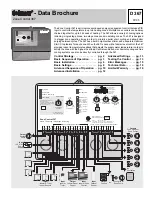
11
Common Blocks
The 367 has 3 common blocks for both the RTU inputs and relay outputs. Each common block has a terminal starting with
Com
(e.g.
Com Sen or Com 1-2 ). When the DIP switch is set to One Stage & Floating, each common block can be used for either two
One Stage zones or one Floating action zone. One Stage common blocks are explained on page 4 of this brochure.
Floating Action Common Blocks
When the DIP switch is set to
One Stage & Floating and a single RTU is connected to the highest terminal
number in the common block, a Floating Action zone is created. The single RTU controls two relay outputs
- an
Open relay and a Close relay. The Motor Speed dial is used to set the time required for the floating action
actuating motor to go from fully closed to fully open.
Example An RTU connected between the terminals
Com Sen — RTU 2, is used to control the output relays
1 and 2. Relay 1 is the Open relay and relay 2 is the Close relay.
Each floating zone is controlled by repositioning the floating action valve every 15 minutes
based on the space temperature in the zone. The control uses PID logic to maintain an
accurate space temperature. When the measured space temperature is above or below
the desired setpoint, the 367 calculates a new position for the valve and then operates
the
close or open relay in order to achieve the new position. The floating action output is
designed for either linear modulating injection valves that change the supply water
temperature to the terminal unit or equal percentage modulating valves that change the
flowrate through the terminal unit.
VENTILATION
The 367 can be used to operate a ventilation system. When the DIP switch on the 367 is
set to
Zone 2 Ventilating, the 367 ignores the RTU 2 terminal and utilizes the output relay
2 to operate the ventilation system. During the Occupied period, the output relay 2 is turned
on, and during the UnOccupied period the output relay
2 is turned off. The ventilation system
is therefore only operated during occupied periods in order to conserve energy. If
Optimum
Start is selected, the 367 starts the ventilation system one hour before the Occupied period
begins. This allows sufficient time to purge the air for normal occupancy.
FREE COOLING
If the DIP switches are set to both
Zone 1 Cooling and Zone 2 Ventilating,
the 367 can operate a fan and damper to bring outside air into the building
for free cooling. An Indoor Sensor or RTU must be connected between
terminals
Com Sen — RTU 1 and an Outdoor Sensor must be connected
to
Com Sen — Out Sen. Whenever cooling is needed and the heating
zones have been satisfied for at least 45 minutes and the outdoor air
temperature is at least 3
°
F colder than the indoor air temperature, the 367
turns on relays
1 and 2 together. The 367 varies the on time of output
relays
1 and 2 over a 30 minute period. As the cooling load increases, the
on time of the output relays increases.
Combining Ventilation, Free Cooling & Mechanical Cooling
All three systems (ventilation, free cooling and mechanical cooling)
can be operated through the appropriate wiring, as shown in the
adjacent diagram. When the 367 is used to operate all three systems,
the output relay
2 (ventilation) is turned on during occupied periods
whenever cooling is not being done. The 367 operates both output
relay
1 and output relay 2 (free cooling) when cooling is required and
the outdoor temperature is below the desired indoor temperature.
When the outdoor temperature is warmer than the desired indoor
temperature, the 367 turns off output relay
2 and turns on output relay
1 in order to run the mechanical cooling system.
DEMAND LIMITING (
Design Outdoor dial)
The heat supplied to the zones can be limited based on outdoor temperature. Demand Limiting is an energy
saving function that is used to prevent excessive energy consumption when there is an unnecessary heating
load such as an open window during moderate outdoor conditions. This function should only be used if the 367
is not connected to a tekmar reset control. When the
Design Outdoor dial is turned up from the Off position
and an outdoor sensor is present, the demand limiting function is enabled. Based on the outdoor temperature,
the control restricts the maximum on time of the zone relays. The control allows a full 15 minute on time when
the outdoor temperature reaches the temperature set on the
Design Outdoor dial. Above this temperature the
maximum on time is reduced until the outdoor temperature reaches the WWSD point where the maximum on
time is zero.
H
C
R
N
C
Floating Zone
Com
1-2
19
1
20
2
21
Com
Sen
5
6
RTU
1
RTU
2
7
Floating Motor
Speed
130 sec.
30
230
100
200
3
4
6
5
7
2
1
8
3
4
6
5
7
2
1
8
M
M
Cool
24 V (ac)
120 V (ac)
N
L
C
R
Zone 1 Cooling
Zone 2 Ventilating
Damper
motor
Fan
2
21
1
20
19
Com
1-2
Zone 2 Ventilating
0
°
F
-40
Off
Design Outdoor
30


































